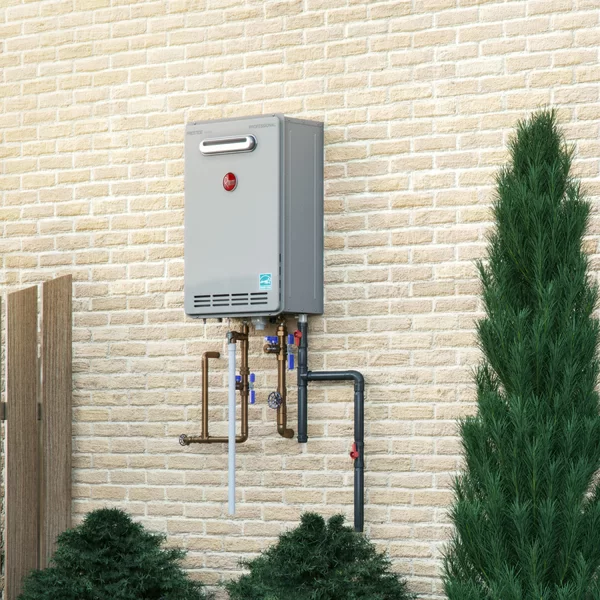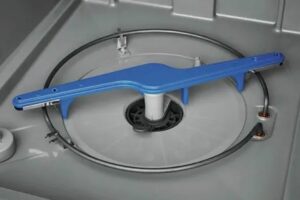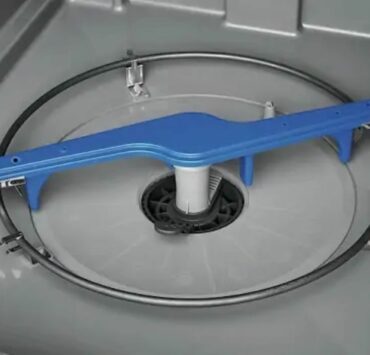Whether you have a tankless water heater or are considering having one, here are some helpful things to know.
What is a tankless water heater? A tankless water heater is an alternative to a storage water heater. Instead of storing hot water, it heats on demand.
Cold water is fed through a heating unit where the water is heated instantly then coursed through your home. Tankless water heaters can heat 2-5 gallons of water per minute.
The heating unit can be powered by gas or by electricity. A gas tankless water heater heats up water by a gas burner while an electric tankless water heater has electrical-resistance heating coils.
Pros Of A Tankless Water Heater
Tankless water heaters cost more up front than a storage water heater and are priced at a premium. However, in time, tankless water heaters prove to be the more energy-efficient and economic option. This is because the unit supplies you with as much hot water as you use, as opposed to a storage tank heater that heats up a set volume of water, regardless if you use it or not.
Often, in the case of storage tank water heaters, an excess amount of water is heated but not used. As the unused hot water cools, you use more power to re-heat the water.
Tankless water heaters aren’t just more energy efficient, they take up less space than a storage tank water heater, so much so that they can be wall mounted. Dimensions of a tankless water heater typically range from 10-30 inches high and 7-20 inches wide. This is a great space saving option seeing as storage tank water heater sizes are cylinders built to carry 30 gallons of water for a small unit and up to 80 gallons of water for large units.
You can customize the settings on tankless water heaters. You can control how much gas/electricity is used, the amount of water flow as well as how hot you want the water to be.
Lastly, tankless water heaters are easy to maintain. If you’re wondering how long does a tankless water heater last, know that when cared for properly, a tankless water heater can have a life expectancy of 20 years. Even when specific parts are damaged, they are easily replaced.
Cons Of A Tankless Water Heater
A tankless water heater can underperform in water temperature and water pressure if the unit is connected to several areas that are using hot water simultaneously. Water pressure and temperature goes down if a single tankless water heater is overused. The unit itself will automatically shut down as well when overloaded.
Proper ventilation is crucial in tankless water heaters as it’s both a performance and safety issue. If the air supply gets blocked and poor ventilation is prolonged, this is a fire hazard.
For gas heaters, water and gas valves that are not fully open can fail to heat water altogether. While this is easily remedied, it’s sometimes hard to identify when troubleshooting any heating issues.
How To Install A Tankless Water Heater
For initial safety and long term safety, a tankless water heater is best done by a professional plumber or electrician, or an installer recommended by the supplier of your unit. Gas models can cost $1,000 to $1,500 to install while electric models can cost $800 to $1,500.
To install a tankless water heater, take note of these steps:
- First, shut down the water, gas, and electricity, accordingly.
- Run the gas line to the water heater.
- Create a hole on the outside of your home and run PVC pipes which will act as ventilation.
- Connect the cold water line and run it into the heater, and connect the hot water line to run out of the heater.
- For electrical water heaters, an electrical outlet will be created near the water heater.
- When the power components are set up, test the heater and adjust the manual settings to your preference.
How To Clean Tankless Water Heater
Mineral build up is inevitable in tankless and storage water heaters alike. Hard water deposits can hinder the functioning of tankless water heaters, and when left unchecked, will cause it to stop working.
You ofcourse don’t want to reach a mineral deposit thick enough to cause your unit to stop working, so cleaning your tankless water heater regularly is good practice to prolong the unit’s life and keep it working optimally. Aim for at least once a year. If you live in an area with hard water, you may need to clean your heater 2 to 3 times a year.
To clean your tankless water heater, you’ll need to flush it. Prepare a 5 gallon bucket, 4 gallons of undiluted white vinegar, a submersible pump and a pair of stainless steel washing machine hoses.
First and foremost, check if you have isolation valves. These valves allow you to shut off a specific portion of your pipeline. Isolation valves are part of a proper installation job and should be there if you had a professional setup your water heater. If you don’t have installation valves, your best option, for safety reasons, is to hire a professional to flush your water heater.
Second, check your units manual and take note of any specific instructions for flushing your unit.
Once you have shut off the isolation valves for the water and power, here’s how to flush a tankless water heater.
Gas Water Heater:
- Disconnect the electrical power to the heater and ensure that there’s no electricity flowing by checking with a non-contact voltage meter.
- Open the hot water pressure valve and release any stored pressure.
- Connect the hoses of your submersible pump into both the cold and hot water service ports.
- Place the submersible pump into your bucket.
- Connect the cold water hose to the pump and place the hot water hose into the bucket.
- Pour in 4 gallons worth of undiluted white vinegar into the bucket.
- Open the hot and cold service ports and turn on the pump, allowing the vinegar to through the heater for at least an hour.
- After an hour has passed, turn off the pump and pour out the vinegar.
- Close the cold water service port and remove the hose.
- Once the water has fully drained, remove the second hose.
- Close the hot water service port.
- Where applicable, remove the heater’s filter and flush them under fresh running water.
- Put back the filters followed by the access panel.
- Open the gas valve and reconnect the electrical supply.
Electric Tankless Water Heater:
- Shut off the electrical power at the breaker and close the cold water shut-off valve.
- Drain any residual water left in the heater by opening the faucets.
- Close the hot water shut-off valve.
- Using a non-contact voltage tester to make sure there’s no power.
- Remove the heating element and check for damage. If damaged, get a replacement heating element.
- Place the heating elements in the copper chambers of the heater so it can also get flushed.
- Fill the copper chambers with undiluted white vinegar.
- Allow the vinegar to sit in the chamber for 1.5 to 2 hours before draining.
- Put back heating elements in their proper place.
- Open the cold water shut-off valve and let the tank fill, checking for any leaks.
- Open the hot water shut-off valve.
- Turn on the faucets connected to the water heater and let the hot water run to clear out any remaining vinegar.
- Close the cold water shut-off valve and remove the inlet filter.
- Run the filter under water to remove any build up before putting it back.
- Close the access panel and restore the power.
Now that you know more about tankless water heaters, you can now better decide what water heating unit best suits your home.



